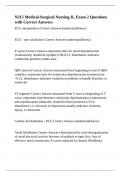N215 Medical-Surgical Nursing II, Exam 2 Questions
with Correct Answers
ECG interpretation Correct Answer-(understand/know)
ECG - rate calculation Correct Answer-(understand/know)
P waves Correct Answer-represents time for atrial depolarization
(contraction); should be upright; 0.06-0.12; disturbance indicates
conduction problem within atria
QRS interval Correct Answer-measured from beginning to end of QRS
complex; represents time for ventricular depolarization (contraction);
<0.12; disturbance indicates conduction problem in bundle branches or
ventricles
ST segment Correct Answer-measured from S wave to beginning of T
wave; represents time between ventricular depolarization (contraction)
and repolarization (diastole); should be flat (isoelectric); 0.12;
disturbance i.e. elevation or depression usually indicates ischemia,
injury, or infarction
Cardiac dysrhythmias - ECG Correct Answer-(understand/know)
Atrial fibrillation Correct Answer-characterized by total disorganization
of atrial electrical activity because of multiple ectopic foci; loss of
effective atrial contraction; P waves replaced by chaotic fibrillatory
,waves, w/ typically irregular ventricular rate; results in decreased CO,
increased risk of thrombi w/ resulting emboli; treatment includes
calcium channel blockers/beta-adrenergic blockers/dronedarone/digoxin
for rate control or electrical cardioversion, or anticoagulants if unable to
convert
Atrial flutter Correct Answer-recurring regular sawtooth-shaped flutter P
waves originating from a single ectopic focus in the right or left atrium;
ventricular and atrial rates are usually regular; results in decreased CO,
eventual HF, increased risk of stroke (thrombi/emboli); Warfarin given
to reduce stroke risk
Ventricular tachycardia Correct Answer-run of 3 of more PVCs; occurs
when the ventricles take control as the pacemaker; this is a life-
threatening dysrhythmia, may degenerate into VF; may be seen in
patients w/ no evidence of cardiac disease; rate 150-250 bpm, regular or
irregular, AV dissociation w/ P wave usually buried in the QRS
complex, QRS >0.12; results in severely decreased CO, hypotension,
pulmonary edema, decreased cerebral blood flow, cardiopulmonary
arrest; treatment includes IV drugs and/or cardioversion, CPR, rapid
defibrillation
Ventricular fibrillation Correct Answer-severe derangement of HR
characterized by irregular waveforms of varying shapes and amplitude;
ventricle is simply "quivering," w/ no effective contraction, meaning it is
a lethal dysrhythmia; HR is not measurable, rhythm is irregular/chaotic,
P wave is not visible, PR/QRS intervals not measurable; results in
unresponsive, pulseless, apneic state w/ eventual death; treatment
consists of immediate CPR and defibrillation, and ACLS w/ use of
defibrillation and definitive drug therapy (e.g. epinephrine, vasopressin)
,PVCs (premature ventricular contractions) Correct Answer-early (extra)
occurrence of a QRS complex; originates from abnormal ectopic
focus/foci in the ventricles; may be classified as multifocal or unifocal,
ventricular bigeminy or trigeminy; R-on-T phenomenon results in
greatly increased risk to start VT or VF; associated w/ stimulants,
electrolyte imbalance, hypoxia, fever, exercise, emotional stress; usually
not harmful in patient w/ normal heart, but w/ heart disease may reduce
CO and lead to angina and HF (dependent on frequency)
Heart blocks Correct Answer-first-degree, second-degree type I, second-
degree type II, third-degree (understand/know)
Sinus rhythms Correct Answer-normal sinus rhythm, sinus bradycardia,
sinus tachycardia
Cardiac dysrhythmias - assessment Correct Answer-P wave (upright or
inverted, correspondence w/ QRS complex, flutter or fibrillatory), atrial
rhythm (regular or irregular), atrial rate, PR interval (normal or
prolonged), ventricular rhythm (regular or irregular), ventricular rate,
QRS complex (normal or prolonged), ST segment (isoelectric, elevated,
depressed), QT interval (normal or prolonged), T wave (upright or
inverted); what is the dominant rhythm/dysrhythmia, what is the clinical
significance of these findings, what is the treatment if any for this
particular rhythm; findings typically include irregular rate/rhythm,
tachycardia, bradycardia, decreased or increased BP, decreased SpO2,
chest/neck/shoulder/back/jaw/arm pain, dizziness, syncope, dypsnea,
extreme restlessness, anxiety, decreased LOC, confusion, feeling of
impending doom, numbness, arm tingling, weakness, fatigue, cold
, clammy skin, diminished peripheral pulses, diaphoresis, pallor,
palpitations, nausea, vomiting
Cardiac dysrhythmias - complications Correct Answer-decreased CO,
hypoxia/hypoxemia, dyspnea, hypotension, dizziness/syncope,
pulmonary edema, decreased cerebral blood flow, cardiopulmonary
arrest, thrombi and/or emboli followed by PE or stroke, myocardial
ischemia, angina, HF or MI, cardiogenic shock, death
Cardiac dysrhythmias - medications Correct Answer-sodium channel
blockers (decrease impulse conduction); disopyramide, procainamide,
quinidine (delay repolarization, widened QRS and prolonged QT);
mexiletine, phenytoin (accelerate repolarization, little to no effect on
ECG); flecainide, propafenone (decrease impulse conduction,
pronounced prodysrhythmic actions w/ widened QRS and prolonged
QT); esmolol, metoprolol, propanolol (decrease SA node automaticity,
slow AV node impulse conduction, reduce atrial/ventricular
contractility, bradycardia, prolonged PR interval, AV block);
amiodarone, bretylium, dofetilide, ibutilide, sotalol (delay repolarization,
prolonged PR and QT, widened QRS, bradycardia); diltiazem, verapamil
(decrease SA node automaticity, delay AV node conduction, reduce
myocardial contractility, bradycardia, prolonged PR interval, AV block);
adenosine, digoxin (decrease AV node conduction, reduce SA node
automaticity, prolonged PR, AV block); dronedarone (suppresses atrial
dysrhythmia, prolonged QT); magnesium (decreases AV node impulse
conduction, AV block)
Cardiac dysrhythmias - cardioversion Correct Answer-therapy of choice
for ventricular or supraventricular tachydysrhythmias; ensure
synchronizer switch is on and pay strict attention to airway; if




